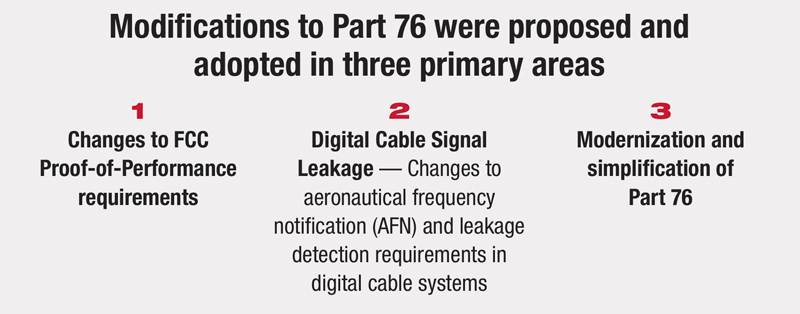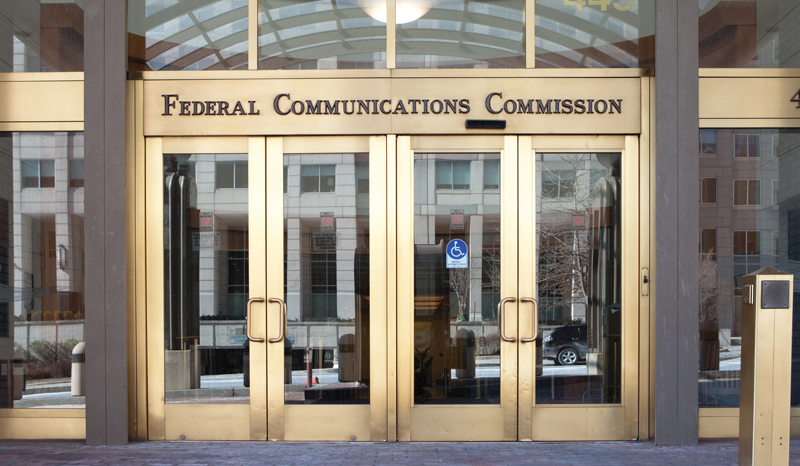Modifications to Part 76 of the FCC Rules
By H. Mark Bowers, Cablesoft Engineering, and Ron Hranac, Cisco Systems
In the latter part of 2012 the Federal Communications Commission issued a Notice of Proposed Rulemaking (NPRM) summarizing, among other things, proposed changes to Part 76 of the FCC Rules pertaining to proof-of-performance testing on digital signals and leakage requirements for digital signals. The NPRM went through the normal comments and reply comments periods, with input from the cable industry and a variety of other interested parties. No action was taken on the NPRM for the next few years as the Commission tackled other priorities.
In 2017 the FCC resurrected activity on the NPRM, and on September 7th published a Report and Order that marked a next step in adopting new Rules. Several changes were approved to existing FCC Part 76 Rules when MB Docket No. 12-217 was adopted in late September 2017. While the effect of those changes has yet to appear in the form of revised Part 76 Rules, the following is a summary of the most important updates.


FCC Proof-of-Performance Requirements
Analog testing requirements remain as-is except for the number of channels that must be tested in the field. Under present Rules, the number of channels tested during field testing is defined by a formula in §76.601(b)(2) that states in part “Unless otherwise as noted, proof-of-performance tests for all other standards in §76.605(a) shall be made on a minimum of four (4) channels plus one additional channel for every 100 MHz, or fraction thereof, of cable distribution system upper frequency limit.” The revision, in an attempt to simplify the requirement and wording, states the operator must (field) test “five channels on systems with a channel capacity of less than 550 MHz, and test ten channels on systems with a channel capacity of 550 MHz or more.”
This raises the issue of what is meant by “channel capacity.” Historically, this has been interpreted to mean “activated channel capacity,” or the operational capacity available to the operator without having to make changes (limited or major upgrade) to the network. For example, an HFC plant might employ 1 GHz actives and passives, however, if the amplifier spacing and equalization are at 750 MHz, the channel capacity is 750 MHz. Most modern HFC plants have at least 550 MHz of spectrum available for the carriage of analog and QAM carriers; thus most operators will now have to test 10 analog channels when conducting the field test portion of the analog testing requirements.
QAM testing requirements. The Commission will continue to require operators to adhere to SCTE 40 (2016 edition) standards for all QAM carriers; however the FCC declined to adopt digital proof-of-performance testing and record keeping requirements. While the aforementioned may simplify testing during the bi-annual proofs, it still implies that some level of periodic testing on all QAM carriers should be conducted, since without testing how can operators be sure that their digital channels comply with SCTE 40 2016? This area may require further clarification once the revised Rules are released.
Non-QAM digital delivery systems have no performance standards imposed at this time because of the lack of a standardized testing regimen. If an industry testing consensus eventually emerges for IP or other non-QAM delivery systems, the Commission may consider adopting suitable standardized testing requirements.
Digital Cable Signal Leakage
Aeronautical Frequency Notification (AFN) requirements for analog carriers remain as before.
AFN for QAM carriers is now required for any QAM carrier that meets or exceeds “1 x 10-5 watts over a 30 kHz bandwidth in any 2.5 millisecond time period.” After adjusting for the change in bandwidth as compared to the typical 6 MHz bandwidth measurement for QAM carriers (this increases the allowable RF level relative to an analog carrier) plus the increased likelihood of interference because a +12.5 kHz or +25 kHz offset has no effect interference-wise with a QAM carrier (reduces the allowable RF carrier level), the net result is that any QAM carrier operating in a protected aeronautical frequency band (108 MHz to 137 MHz, 225 MHz to 400 MHz) with an average power level (measured in a 6 MHz bandwidth) that meets or exceeds +27.5 dBmV (1) requires an AFN to be filed. A more detailed explanation on how these two offsetting factors are calculated is found in the FCC MB Docket.
Analog signal leakage detection methods and allowable leakage levels remain unchanged, as long as the analog carrier utilized for leakage detection measurements is at least 1.2 dB higher (the same reasoning is used here as in the AFN requirement explanation) in RF amplitude than the average power level of the QAM carriers in the network.
Signal leakage detection methods and systems that utilize QAM carriers must be able to demonstrate that they are accurate and correlate closely with analog detection methods. There are detection systems available from several test equipment vendors that allow for accurate detection of very low-level QAM carrier leakage. When signal leakage detection is performed utilizing a QAM carrier, the allowable leakage level is reduced by the same 1.2 dB as noted in other areas and measurements. In application, this correlates to a practical leakage limit of 17.4 microvolts per meter (μV/m) at 3 meters (108 MHz to 137 MHz) in those systems which operate digital signals in the aeronautical bands.

The important thing to note for now is that the Commission has chosen to not impose any specific measurement methodology, but rather adopted a flexible rule that allows for the operator to “demonstrate compliance using a different methodology” if the standard analog leakage detection method is not employed.
Whether the leakage is measured on an analog or QAM carrier, leakage compliance (quarterly leakage patrolling, record keeping, plus yearly CLI calculations) must still be maintained in the 108 MHz to 137 MHz band, and AFN is still required in the same bands: 108 MHz to 137 MHz and 225 MHz to 400 MHz as described earlier. For now, the Commission has declined to extend leakage measurement requirements into frequencies above 400 MHz.
Note: The harmful interference clause in Part 76 still applies, regardless of frequency or leakage field strength.
The I3000 method of calculating CLI is eliminated in favor of the more effective I∞ method.
Modernization and Simplification of Part 76 Rules
Finally, as part of these changes the Commission seeks to “remove references to effective dates that have passed, make editorial corrections, delete obsolete rules, update various technical standards that are incorporated by reference into the rules, and clarify language in Part 76 of the rules.” We believe it is prudent to wait until the final revised Part 76 rules are available before any sort of summary is attempted in this area of change.
—
For more detail in any given area, the reader is encouraged to review the appropriate section of MB Docket No. 12-217, which is available for download at the FCC website (fcc.gov).
(1) This is 1.2 dB lower than the expected value of +28.75 dBmV for the 1 x 10-5 W stated power limit. This 1.2 dB reduction is the ‘net effect’ of the two offsetting factors already mentioned.
Credit: Mark Van Scyoc / Shutterstock.com

